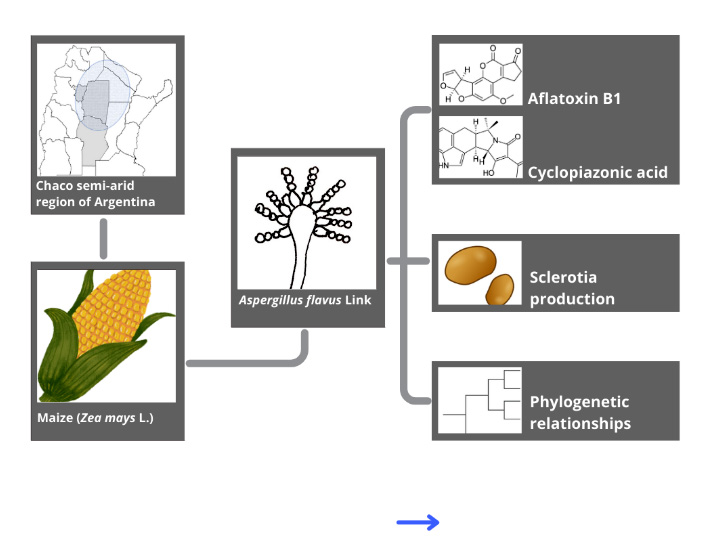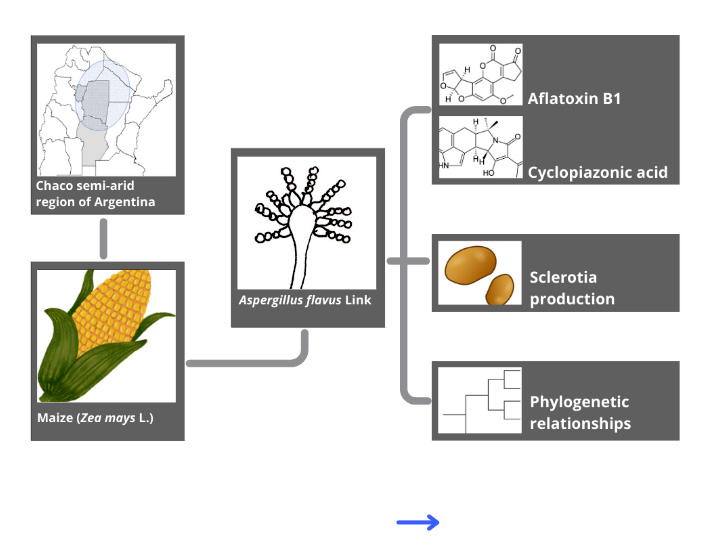A polyphasic study of non-aflatoxigenic Aspergillus flavus Link, isolates from maize in the Chaco semi-arid region of Argentina
DOI:
https://doi.org/10.48162/rev.39.123Keywords:
non-aflatoxigenic isolate, cyclopiazonic acid, sclerotia production, phylogenetic relationshipsAbstract

Maize (Zea mays L.) is one of the most widely planted crops globally with Argentina leading world production and exportation. Santiago del Estero province, east of Tucumán and north of Córdoba encompasses eight agro-climatic zones in the Chaco Semi-arid region, agro-ecologically characterized by a wide temperature range and frequent drought periods that expose the crop to pathogens, particularly Aspergillus flavus. This pathogen is responsible for ear rot and grain contamination with mycotoxins such as aflatoxin B1 and cyclopiazonic acid. This study obtained fungal isolates from ears of maize and characterized them according to toxigenic capability and morphotype of sclerotia (S < 400 μm, associated with high levels of aflatoxins and L > 400 μm, related to variable levels of aflatoxins). In addition, those not producing aflatoxins were studied to determine phylogenetic relationships based on sequences of a segment of the CaM gene. Fifty-eight isolates were obtained in eight localities representing each agro-climatic zone, 30 of which were non-aflatoxigenic, 28 aflatoxigenic, and all producers of ciclopiazonic acid. Six isolates did not produce sclerotia, 51 were L and only one was S, the latter being a non-producer of aflatoxins. The number of sclerotia was positively correlated with the production of aflatoxin B1, while size was negatively correlated. The CaM gene sequences corroborated that the isolates belonged to the A. flavus clade and the high nucleotide similarity among them (99.4% to 100%) revealed almost zero genetic diversity in this geographic region. No significant differences were observed in the proportion of isolates between growing seasons or among agroclimatic districts. This research revealed characteristics of fungus populations in this agricultural region of north Argentina.
Highlights:
- Aspergillus flavus isolates from ears of maize were characterized according to toxigenic capability, morphotype of sclerotia and phylogenetic relationships.
- Fifty-eight isolates were obtained, 30 non-aflatoxigenic, 28 aflatoxigenic, and all producers of ciclopiazonic acid.
- Six isolates did not produce sclerotia, 51 were L and only one was S, the latter being a non-producer of aflatoxins.
- All isolates belonged to the flavus clade. High nucleotide similarity among the isolates (99.4% to 100%) revealed almost zero genetic diversity in the region.

Downloads
Published
Issue
Section
License
Copyright (c) 2018 Revista de la Facultad de Ciencias Agrarias UNCuyo

This work is licensed under a Creative Commons Attribution-NonCommercial-ShareAlike 3.0 Unported License.
Aquellos autores/as que tengan publicaciones con esta revista, aceptan las Políticas Editoriales.


